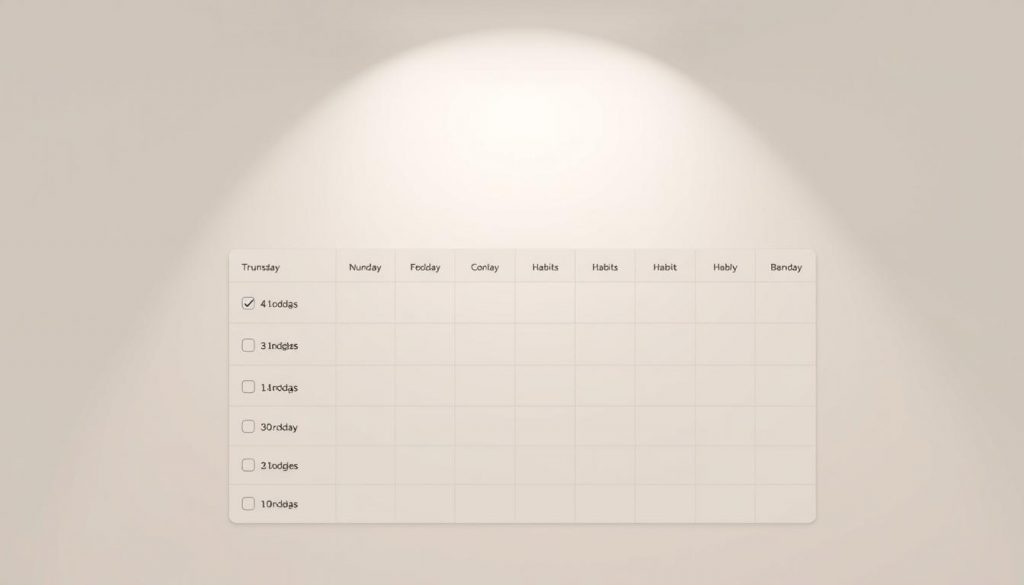Feeling stuck with unmet goals and forgotten resolutions? I’ve been there too. A habit tracking journal can be a game-changer. It’s a powerful tool for self-reflection and growth.
Creative journaling isn’t just writing; it’s a system for progress. Research shows writing goals increases success by 42%. Your journal becomes a personal roadmap for motivation and achievement.
Habit formation is a learnable skill. Tracking 4-5 habits monthly can improve your ability to create lasting change. Many people struggle with consistency, often losing interest after the initial excitement.
Your journal is more than a notebook; it’s a tool for transformation. It can help you improve health, productivity, and relationships. This approach breaks barriers and achieves ambitious goals.
Let’s explore the art and science of habit tracking. You’ll learn to create a journal that tracks progress and inspires self-improvement. Get ready to become the best version of yourself.
Understanding Habit Tracking and Its Benefits
Habit tracking is a powerful productivity technique. It helps transform daily actions into automatic behaviors. Small, consistent steps can lead to remarkable changes in your life.
Tracking habits is more than just record-keeping. It’s a strategic approach to personal development. This method provides clear insights into your progress and motivation.
What Is Habit Tracking?
A habit tracker monitors your daily actions and progress. It creates a visual representation of your personal growth. This systematic method helps you reach specific goals.
- Identifies patterns in your behavior
- Helps visualize progress
- Increases accountability
- Supports long-term goal achievement
Why You Should Track Your Habits
Research reveals fascinating insights into habit formation:
| Habit Formation Timeline | Key Milestone |
|---|---|
| 21 days | Initial habit creation |
| 66 days | Habit becomes automatic |
| 90 days | Habit integrated into lifestyle |
“Success is the sum of small efforts, repeated day in and day out.” – Robert Collier
The Science Behind Habit Formation
Journaling techniques combined with habit tracking can boost productivity. 43% of daily actions are habitual. Understanding these patterns can transform your life.
Track 4-5 habits per month for sustainable growth. Consistency is key, not perfection. Maintain flexibility to create a lasting path to personal improvement.
Choosing the Right Journal for You
The perfect habit journal can transform your personal growth journey. Selecting the right tracking tool is crucial for your success. This applies whether you’re into bullet journaling or creative journaling methods.

Effective habit tracking needs a journal that fits your lifestyle. Research shows that progress trackers are more likely to achieve their goals. Choose a journal that matches your personal preferences.
Types of Habit Tracking Journals
Different journal styles can support your habit tracking adventure:
- Classic Paper Journals
- Digital Tracking Apps
- Bullet Journal Formats
- Minimalist Planners
Digital vs. Paper Journals
Your choice between digital and paper habit journals depends on your lifestyle. Each format offers unique advantages:
| Paper Journals | Digital Journals |
|---|---|
| Tactile experience | Instant syncing |
| No battery required | Easy data analysis |
| Creative customization | Automatic reminders |
Customizing Your Journal Format
Your habit journal should be as unique as you are. Experts suggest tracking three to four habits to avoid feeling overwhelmed.
Customize your approach by:
- Selecting a layout that inspires you
- Using color-coding systems
- Creating visual trackers
- Designing flexible templates
“The best habit journal is the one you’ll actually use consistently.”
Remember, a habit journal should support your personal growth. Choose a format that feels natural and motivating to you. Don’t let it become a source of stress.
Setting Goals: The First Step to Success
Effective goal setting is crucial for personal development. Clear, actionable objectives guide your daily habits and long-term aspirations. They help transform dreams into reality.

Writing down your goals boosts your chances of success. Studies show that people who document their goals are 42% more likely to achieve them. This simple act can make a significant difference.
Defining SMART Goals
The SMART goal-setting framework helps create meaningful objectives. It provides a structured approach to goal setting.
- Specific: Clearly define what you want to accomplish
- Measurable: Establish concrete criteria for measuring progress
- Achievable: Set realistic and attainable goals
- Relevant: Align goals with your broader life vision
- Time-bound: Create a timeline for achievement
“Goals are dreams with deadlines” – Diana Scharf
Aligning Your Habits with Your Goals
Successful personal development requires matching daily habits with long-term objectives. Your journal can track progress and maintain accountability. It becomes a powerful tool for growth.
| Goal Duration | Habit Formation Timeline | Success Probability |
|---|---|---|
| 21 Days | Initial Habit Creation | 30% Habit Retention |
| 66 Days | Habit Automation | 50% Consistent Performance |
| 90 Days | Lifestyle Integration | 70% Goal Achievement |
Consistently tracking progress helps turn aspirations into achievements. Stay committed to your goals. Your journal becomes a roadmap for personal growth and success.
Creating Your Habit Tracker
A well-crafted habit tracker can boost your personal growth. Your bullet journaling method is crucial for monitoring progress. It helps you see and reach your goals clearly.

When making your habit tracker, think about these key parts. They’ll make your tracking more effective:
- Limit your tracked habits to 4-5 items per month
- Create a flexible layout that adapts to your lifestyle
- Use visual indicators to track progress
- Allow space for reflection and notes
Essential Components of a Habit Tracker
Your habit tracker should work well and inspire you. Dan Knowlton’s method focuses on planning to save daily decision energy. This makes tracking easier.
| Tracker Element | Purpose |
|---|---|
| Daily Checklist | Track consistent habit completion |
| Progress Arrows | Show momentum between consecutive days |
| Reflection Space | Note challenges and achievements |
Designing a User-Friendly Layout
Personalizing your habit tracker is crucial. Choose a layout that matches your style and motivators. Studies show that custom spreads lead to higher engagement.
“Your habit tracker is a personal roadmap to self-improvement, not a rigid rulebook.”
Tracking habits isn’t about being perfect. It’s about steady effort. Some days you’ll do great, others not so much. That’s okay.
The aim is to build momentum and learn as you go. Your journey is unique, so embrace the process.
How to Start Using Your Habit Tracking Journal
Building habits with journals needs careful planning and commitment. Your productivity depends on a sustainable approach that fits your daily routine. Creating a method that works for you is key to success.

“It’s not goal attainment, but the process of striving after goals—that is growth—that brings happiness.” – Gretchen Rubin
Effective habit tracking starts with a consistent method. Successful trackers follow key principles to achieve their goals. These principles help maintain focus and create lasting change.
- Start with 4-5 habits to maintain focus
- Create a realistic tracking frequency
- Design a flexible journal layout
- Set clear, specific intentions
Establishing a Routine
Creating a habit tracking routine takes dedication. Experts suggest setting aside time each day for journaling. Consistency is crucial: it takes 21 days to form a habit.
After 66 days, the habit becomes automatic. Choose a time that works best for you, like morning or evening.
Choosing Your Tracking Frequency
Your tracking frequency depends on your goals and lifestyle. Consider these options when deciding how often to track:
- Daily tracking for intense habit formation
- Weekly review for broader perspective
- Monthly reflection to assess long-term progress
Statistics show that most people only complete the first week of habit tracking. However, you can beat this trend with smart strategies. Maintaining consistent progress is key to success.
Remember, the goal is not perfection. Focus on making steady progress in your habit-building journey. Small steps lead to big changes over time.
Staying Motivated While Journaling
Motivation is key when tracking habits and pursuing personal growth. Your habit journal can inspire and engage you throughout your self-reflection journey.

Keeping your habit journal exciting requires smart strategies. Let’s explore effective ways to maintain your enthusiasm.
Tips to Keep You Engaged
- Set realistic expectations for your habit tracking
- Choose visual tracking methods that excite you
- Create a consistent journaling routine
- Use colorful stickers or markers to make entries fun
“Small progress is still progress. Celebrate every step forward.” – Anonymous
Celebrating Small Wins
Recognizing your achievements boosts motivation, no matter how small. Research shows that tracking small victories provides daily positive reinforcement.
| Tracking Duration | Habit Automation Potential |
|---|---|
| 21 days | Initial habit formation begins |
| 66 days | Habit becomes more automatic |
| 90 days | Habit integrates into lifestyle |
Your habit journal is more than just a tracking tool. It’s your personal growth companion.
By using these strategies, you’ll turn journaling into an inspiring self-reflection practice. Your daily entries will become a rewarding part of your routine.
Analyzing Your Progress Regularly
Progress tracking is crucial for personal growth and goal achievement. Your habit tracking journal helps you reflect and improve. By reviewing your entries, you gain insights into your progress and development journey.
Effective progress tracking needs a systematic approach. Here are key strategies for analyzing your habit development:
- Review entries consistently (weekly or monthly)
- Look for patterns in your behavior
- Identify areas of success and potential improvement
- Adjust goals based on your observations
Reviewing Your Entries
Goal-setting through writing becomes powerful when you examine your journal entries critically. Research shows it takes 21 to 66 days to establish a solid habit. Patience is crucial.
Pay attention to these aspects:
- Consistency of habit performance
- Emotional responses to different habits
- Obstacles encountered during habit formation
- Unexpected benefits or challenges
Adjusting Habits as Needed
Flexibility is key in habit development. If habits don’t serve your goals, modify them. Your journal should evolve with your personal growth.
“Progress is impossible without change, and those who cannot change their minds cannot change anything.” – George Bernard Shaw
Self-reflection isn’t about perfection, but continuous improvement. Celebrate small wins and see challenges as growth opportunities.
Common Mistakes to Avoid in Habit Tracking
Building consistent habits can be challenging. Many people make critical errors that hinder their productivity and journaling techniques. Let’s explore common pitfalls and how to avoid them.
Overcomplicating Your Tracker
Creating an overly complex system is a major mistake in habit tracking. Dan Knowlton’s research shows that listing 8 daily tasks isn’t sustainable for building habits.
Instead, keep your habit tracker simple and manageable. Focus on a few key habits at a time for better results.
- Avoid creating elaborate tracking systems
- Keep your habit tracker simple and manageable
- Focus on a few key habits at a time
Setting Unrealistic Expectations
Your habit tracker should empower, not frustrate you. Studies show that over 50% of New Year’s resolutions fail by January’s end. This is mainly because people set unrealistic goals.
“What gets measured gets managed” – highlighting the importance of realistic tracking
| Mistake | Impact | Solution |
|---|---|---|
| Overwhelming Goals | High Failure Rate | Start with Minimal Commitments |
| Perfectionism | Demotivation | Embrace Small Progress |
| No Accountability | Easy to Quit | Share Goals Publicly |
A European Journal of Social Psychology study reveals an important finding. Missing a single day does not derail long-term habit formation. Consistency, not perfection, is key.
Start small and track your progress. Remember, top performers view mistakes as learning opportunities. This mindset can help you stay motivated.
- Begin with minimal daily commitments
- Use social accountability
- Learn from mistakes without judgment
Incorporating Reflection into Your Journaling Practice
Reflective journaling turns habit tracking into a powerful growth tool. It helps you understand your inner world and behavior patterns better. Self-reflection opens doors to personal insights and development.
Benefits of Reflective Journaling
Creative journaling offers deep psychological benefits for personal growth. Michigan State University research shows mindful writing has several advantages.
It frees up cognitive resources and reduces mental stress. Additionally, it enhances emotional intelligence and improves overall mental wellness.
- Free up cognitive resources
- Reduce mental stress
- Enhance emotional intelligence
- Improve overall mental wellness
“Writing is a powerful tool for understanding ourselves and our experiences.” – Julia Cameron
Prompts to Inspire Reflection
Try these thought-provoking prompts to spark meaningful self-discovery in your journaling practice:
- What habits have challenged me most this week?
- How do my current actions align with my long-term goals?
- What unexpected insights have I gained about myself?
- What small victory can I celebrate today?
A one-line-a-day approach helps capture brief yet powerful reflections. This consistent practice creates a rich tapestry of personal growth over time.
Reflective journaling is about genuine exploration, not perfection. Your journal is a safe space for understanding motivations and celebrating progress. Use it to gently adjust your course when needed.
Conclusion: Making Habit Tracking a Lifelong Practice
Habit-building with journals is an ongoing journey. It’s a continuous process that needs commitment and self-reflection. By making habit tracking a lifestyle, you’re investing in your growth and potential.
Goal setting becomes more powerful with daily habit tracking. Users who track habits for three weeks see big improvements. Your journal is a tool for self-awareness that adapts to your changing goals.
Embracing Habit Tracking as a Lifestyle
See your habit tracker as a dynamic companion. It’s about progress, not perfection. Effective tracking helps you see growth and spot patterns.
Your journal can guide you toward meaningful change. This applies to fitness, nutrition, or professional skills.
Future Goals and Habits to Explore
Expand your tracking to cover all areas of life. Track water intake or emotional well-being. Your journal can become a tool for overall self-improvement.
Start small and stay consistent. Watch how these small changes lead to big personal growth.
FAQ
What exactly is a habit tracking journal?
How often should I update my habit tracking journal?
Can I use a digital app instead of a physical journal?
How many habits should I track at once?
What are SMART goals, and how do they relate to habit tracking?
How can I stay motivated when tracking habits?
What if I miss a day in my habit tracking?
Can habit tracking help with mental health?
How long does it take to form a new habit?
What’s the best way to design my habit tracker?
Source Links
- Intentional Habit Tracking
- How to Track Habits and Goals with a Bullet Journal – Andrea Peacock
- Why Habit Trackers and Journaling are Key to Reaching your Goals
- Intentional Habit Tracking
- The Clear Habit Journal
- The Ultimate Habit Tracker Guide: Why and How to Track Your Habits
- Top 10 Goal Setting Journals to Help You Reach Your Goals — Hatch Tribe
- Why Habit Trackers and Journaling are Key to Reaching your Goals
- How to Set and Achieve Goals with Journaling | Erin Condren
- Intentional Habit Tracking
- Bullet Journal Habit Tracker Ideas To Help You Make Lifestyle Changes
- Intentional Habit Tracking
- Why Habit Trackers and Journaling are Key to Reaching your Goals
- Keep A Daily “Wins Journal” To Increase Stamina And Motivation
- Habit Tracker – Habit Diary – Apps on Google Play
- Habit Journal: Tracking Your Habit to Maintain Growth
- Avoid the Second Mistake
- How Habits Fail: Common Mistakes in Habit Formation | Forces of Habit
- Transforming Self-Care: How I Use ChatGPT for Reflective Journaling
- Journaling Techniques to Help You Start a Journaling Practice – Beth Foreman
- 11 Things to Track in Your Monthly Habit Tracker
- A Visionary Life Daily Awareness Practices an Elevated Habit Tracking
- Benefits Of Using A Habit Tracker – Cute Little Paper
